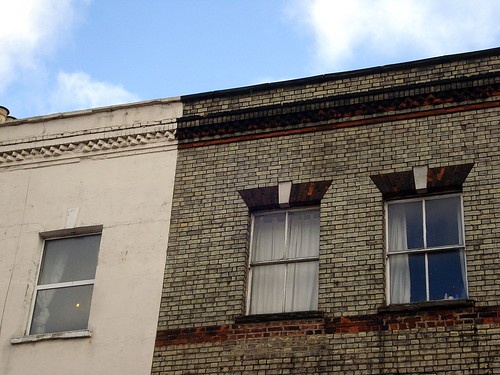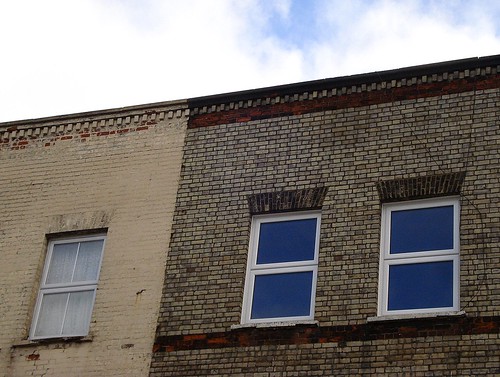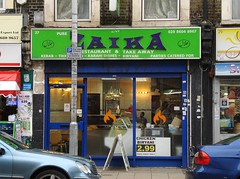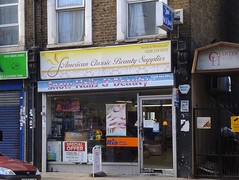28 London Road is the home of First Choice Bakers, self-described as “producers & suppliers of the finest quality Jamaican patties, English & Caribbean breads, buns, confectionary & other specialties”.
1860s–1870s: Construction of Oakfield Terrace; differences between the two halves
28 London Road was constructed, along with numbers 30–34, some time around 1868–1872. By 1874, these four buildings were numbered as 1–4 Oakfield Terrace, and by 1876, numbers 5–8 Oakfield Terrace had been built to join them, completing the stretch now numbered as 28–42 London Road.[1]
There are only very minor differences between the two halves of the terrace. The cornices of numbers 28–34 bear small rectangular downward-pointing crenellations, in contrast to the outward-pointing triangles adorning those of numbers 36–42. Both sets of buildings have a vertical fan detail in the brickwork above the windows, but the fans on numbers 36–42 point further outwards and have a larger central keystone. Today, these differences are most easily visible on the frontages that haven’t been painted/plastered over, namely First Choice Bakers itself, and Suave Living and Western Centre further up at numbers 36 and 38 respectively.[2]
1870s–1880s: Ironmongery and bootmaking
The first occupant of 1 Oakfield Terrace — or 28 London Road as it’s known today — was Thomas G Newton, general furnishing ironmonger, who was in place by 1873 but gone again by 1878. His replacement was a bootmaker named Frederick Penn, though he also had a short tenure lasting only until around 1882.[3]
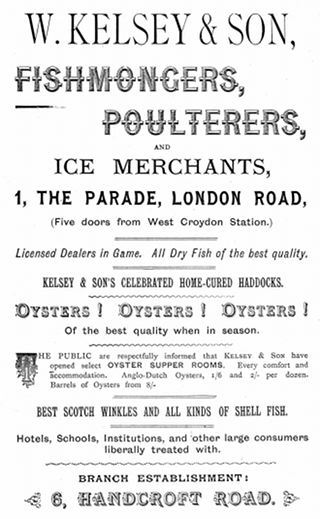

1880s–1910s: Fishmongers
The next type of retail to take place on the premises was rather longer-lasting. Around 1884, William Kelsey opened a fishmongers which was to remain under various owners for over three decades. By 1888 the business was known as W Kelsey & Son, trading as a fishmonger, poulterer, and ice merchant with a second branch at 6 Handcroft Road.[4]
In an advertisement from the same year (shown here), W Kelsey & Son proudly advertised its own “celebrated home-cured haddocks”, “best Scotch winkles and all kinds of shell fish”, and “all dry fish of the best quality”. The “oyster supper rooms” mentioned here may have been on the first or second floor of the building.
As shown in the advertisement, by this point Oakfield Terrace had been renamed to The Parade; according to Ward’s street directories, this happened around 1885–1886. I haven’t been able to find out why this renaming took place.
Note also the claim that W Kelsey & Son was only “five doors from West Croydon Station”. At this date, there were indeed only four other properties between here and the closest railway building: W H Morgan, fruiterer, at the modern number 16; Mrs Kingsland’s registry office for servants at number 18; Samuel Piggott, gasfitter and ironmonger, at number 20; and Henry G Dean, greengrocer and fishmonger, between 20 and 28.[5] However, this closest railway building was not on the site of the entrance today, but rather on the site now occupied by numbers 12–14.[6]
Around 1894, W Kelsey & Son gave way to another fishmonger, John Ansell, who in turn was replaced by Charles James Roberts around 1897. Charles James Roberts was the last of number 28’s fishmongers, and had left the premises by around 1917.[7]
1920s: Joyce’s Dairies/North Park Dairy
After a couple of years of vacancy, John Joyce’s dairy arrived at the premises around 1920, and remained in place for the next decade. This business was listed in contemporary phone books as Joyce’s Dairies, and in Ward’s street directories as North Park Dairy. It also had a branch on Lower Addiscombe Road and two branches in Thornton Heath (one further up London Road and another on Bensham Lane). I haven’t found any evidence of branches outside the Croydon area, so it seems to have been a fairly small, local concern.[8]
1930s: The Express Dairy Co
By early 1929, Joyce’s dairy had been swallowed up by a much larger company — the Express Dairy Co Ltd. This already had a presence in Croydon, with branches on the High Street and on Shirley Road in Addiscombe, but it also took over all four of Joyce’s branches.[9]
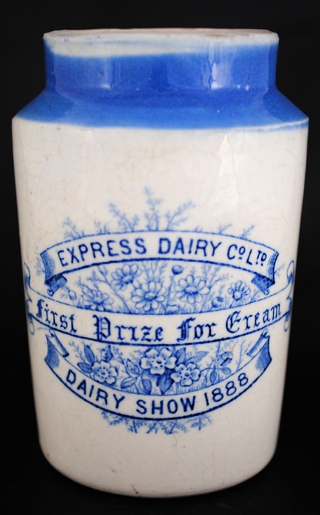
Established in 1864 by George Barham, the Express Dairy Co was a strong innovator in its field. At the time of its founding, it was one of the first dairy companies to use the railways to bring fresh milk into London from farms in the countryside, rather than relying on cows kept within the city itself. George Barham is also credited with inventing new dairy equipment, including steel milk churns based on similar containers used by breweries.[10]
By the time it took over Joyce’s, the Express Dairy Co had branches all over London. The September 1930 London phone book bears a full-page advertisement, grandly entitled “Express Dairy Company’s Telephone Directory”, listing seven farms, seven milk bottling depots, 131 branch dairies, 18 “refreshment depots” (i.e. teashops/cafés), and analytical and bacteriological laboratories.
The branch at 28 London Road was one of these cafés for at least part of its life; a photo held at the Croydon Local Studies and Archives Service shows it with “Express Dairy Co. Ltd.” on the frontage and “Express Cafe” on a small projecting sign.[11] Some clues as to the type of food served at the Express Dairy cafés may be gleaned from a scene in Chapter 2 of Michael Innes’ mystery novel Secret Vanguard, published in 1940. This scene is set in the Express Dairy near the British Museum,[12] and one of the characters (a museum curator) is described as having ordered a glass of milk and some baked beans on toast.
I’m not sure whether the Express Dairy Co used 28 London Road for retail and refreshments at the same time, or whether the use of the premises changed during its tenure. It’s not a large space, and for most if not all of the time the Express Dairy Co was in residence, there was also a dentist practising on one of the upper floors. While the building does have three floors, and hence it’s possible that the Express Dairy Co had two of them, I think it’s most likely that the dentist was on the first floor, and the second floor was residential.[13]
1940s-1980s: Dr Scholl’s
This was certainly the case by the mid-1950s, by which point the ground floor business had become a branch of Dr Scholl’s Foot Comfort Service, the first floor was the business place of F W Fuller, dentist, and the top floor was the residence of Mrs Irene Rivers Pitt, manager at Dr Scholl’s two floors below.[15]
1950s: Jenny Walker
In December 1956, newlywed Jenny Walker moved in to the top floor of 28 London Road, having taken over the flat (though not the manager’s job) from Mrs Rivers Pitt, who was the mother of one of her schoolfriends. During her six years on London Road, Jenny used several local businesses. She bought fish and chips every Friday from the fish shop at number 30, shopped on Saturday mornings at the Sainsbury’s at numbers 9–11 before going for lunch at the Minerva restaurant at number 16, and worked at home in the evenings addressing envelopes for Mrs Sanders’ mailshot business above number 34. Her children’s pram came from Davies Baby Carriages at number 5.[16]
1980s–1990s: Employment agencies and property services
Dr Scholl’s remained at 28 London Road until the mid-1980s, when it was replaced by Atlas Employment Agency, a company that also had branches at 24 George Street and 14 Streatleigh Parade in Streatham.[17]
Atlas was followed by Anthony Gover Property Services, which was in place by 1993 but had been replaced by Carlton Property Services — perhaps simply a renaming of the business — by 1995. Next came Staff Scene Services employment agency, which was open by May 1997 and remained at the property until early 2001.[18]
2000s–present: First Choice Bakers
A period of vacancy followed, but by June 2005 First Choice Bakers had moved in.[19] The company was founded in 1995 and has another branch at 40 Atlantic Road in Brixton as well as a wholesale unit in Mitcham.[20] Its Croydon shop is open 9am–6pm Monday–Saturday, selling Caribbean breads such as bun and hedgehog bread, several flavours of Jamaican pattie, and hot food such as chicken wings.
Thanks to: Brian Gittings; Zom; John Clarke; Colin Withey; all at the Croydon Local Studies Library; and my beta-readers Flash, Kat, and Shuri. Census data and pre-1985 phone books (aside from 1923 Croydon & District) consulted via Ancestry.co.uk.
Footnotes and references
- The 1868 Town Plans (surveyed in 1868, published in 1870) show the land now occupied by 28–42 London Road as two blank white rectangles, signifying land that hadn’t yet been built on. Wilkins’ 1872–3 street directory lists two businesses (Newton the ironmonger and J Church the bootmaker) between J E Hastings (who was at number 20 or 22) and Oakfield Road, and Ward’s 1874 directory confirms the addresses of Newton and J Church as 1 and 4 Oakfield Terrace, respectively, so the buildings of 1–4 Oakfield Terrace (later 28–34 London Road) must have been up by the time Wilkins’ survey was made. Ward’s 1876 directory lists N Gifford, draper, at 3–6 Oakfield Terrace and “unoccupied” at 8 Oakfield Terrace, so the rest of the terrace must have been built by then.
- I have Aileen Turner’s History of Broad Green to thank for pointing out these minor architectural differences, since I hadn’t noticed them before. In this, she notes: “28-42 were originally called Oakfield Terrace, but 28-34 came earlier [...] The owners nowadays seem unable to get them all painted at the same time.” Aileen’s research was conducted in the mid-1970s, and is available at the Croydon Local Studies Library under shelfmark S70 (9) TUR (to my knowledge, this is the only place it’s available). As shown by the photo in this article, her observation about painting still holds true today.
- Thomas G Newton is listed in Wilkins’ 1872–3, Ward’s 1874 and 1876, and Wilkins’ 1876–7 street directories. Frederick Penn is listed in Worth’s 1878 (as F Pen [sic]), Atwood’s 1878 (as F Penn), Ward’s 1878, 1880, and 1882, and Purnell’s 1882 directories. Directories from Ward’s 1884 onwards list William Kelsey, fishmonger. Frederick Penn was aged 62 at the time of the 1881 census, so his leaving Oakfield Terrace may have been due to death or retirement.
- William Kelsey is listed in Ward’s directories from 1884 to 1894 inclusive, initially as William Kelsey, fishmonger, but from 1888 onwards as “Kelsey (William) & Son, fishmongers”. Information on poultry, ice, and Handcroft Road branch taken from advertisement in Ward’s 1888, shown in the present article.
- Henry G Dean was at a property that was demolished around 1899 and replaced by the current numbers 22 and 24–26; see my articles on 22 London Road and 24–26 London Road.
- Prior to the early 1930s, the London Road entrance to West Croydon Station was set back from the road, roughly on the site of the car park between Greggs and H&T Pawnbrokers today. The site now occupied by numbers 12–14 was originally the administrative offices of the London and Croydon Railway company, and later used as the stationmaster’s house; I’m not sure which of these functions it served in 1888. See my articles on 12–14 London Road, West Croydon Station in the 1800s, and West Croydon Station in the 1900s.
- John Ansell, fishmonger, is listed in Ward’s 1895, 1896, and 1897 directories. C J Roberts, fishmonger, is listed in Ward’s directories from 1898 to 1916 inclusive. Kelly’s 1899 directory provides the additional information that Mr Roberts’ full name was Charles James Roberts.
- John Joyce, North Park Dairy, is listed in Ward’s directories from 1920 to 1929 inclusive. The 1923 Croydon & District phone book makes no mention of North Park Dairy, but lists Joyce’s Dairies at 10 London Road (which was renumbered to 28 London Road in 1927), 296 London Road (which was also renumbered in 1927, probably to 542), and 284 Bensham Lane. The October 1922, April 1923, and October 1923 London phone books list J Joyce, dairyman, but only the branch at 296 London Road, suggesting that this was the head office. The September 1928 London phone book lists J Joyce, dairyman, at 542 London Road, 284 Bensham Lane, and 291 Lower Addiscombe Road — presumably the 28 London Road branch was omitted as being less important than the others.
- The September 1928 London phone book lists the Express Dairy Co at 1 Grand Parade, High Street, Croydon; and 58 Shirley Road, Addiscombe. The March 1929 London phone book lists it at the two addresses above plus 28 London Road, 542 London Road, 284 Bensham Lane, and 291 Lower Addiscombe Road. Ward’s street directories list John Joyce at 28 London Road up to and including 1929, and Express Dairy Co Ltd from 1930 onwards.
- Information taken from Baldwin Hamey’s article on the Express Dairy Co., which credits as its main source Marianne Colloms & Dick Weindling, “The cow with an iron tail: the Great Westminster Dairy Company and the Express Dairy”, Camden History Review, 36 (2012), pp. 2-8. See also an article by Ian Mansfield on the same subject.
- Photo reference PH/96 2600. This photo is labelled as “late 1940s”, which is presumably a later deduction rather than a contemporary dating. Although the Express Dairy Co signage is clear on the frontage of number 28, it’s less clear whether the branch is still open.
- The text of Secret Vanguard doesn’t actually state which branch it is, but one of the people in this scene is stated to work at the British Museum. Express Dairies did have a significant presence on Coptic Street near the Museum — see footnote [10] for links to articles with descriptions and photos of this branch, which is now a Pizza Express (and, according to the Pizza Express website, has been so since 1967).
- Ward’s directories list dentists at 28a London Road from 1932 to 1939 (which is the last year in which Ward’s directories were published). The dentist in 1939 is F W Fuller. Kent’s 1955 and 1956 directories list Dr Scholls at 28, Frederick W Fuller, dentist, at 28a, and Irene M Pitt [sic] also at 28a. I know from Jenny Walker (see footnote [16] below) that Irene M Pitt (who she knew as Irene Rivers Pitt) lived on the top floor, so the dentist must have been on the first floor. Indeed, signage for a dentistry business is still visible in the first-floor windows today, though it’s no longer operating as such.
- Dates of dialling code changes taken from slides from a talk by Nicholas Good, Head of Numbering Allocations at Ofcom, in October 2004 (PDF).
- See footnote [13].
- All information in this paragraph comes from an audio-recorded conversation between Jenny and the author, 25 February 2013.
- “Scholl ft/wr” is shown at 28 London Road in Goad plans up to and including April 1986. It appears in the 1985 Croydon phone book but not the 1987 edition. “Altas [sic] emp ag” is shown at 28 London Road in the April 1987, March 1990, and June 1991 Goad plans, and “Atlas Employment Agency Ltd” is listed in the 1987, 1988, and 1990 Croydon phone books; its branches at 24 George Street anf 14 Streatleigh Parade also appear in these phone books. Probably relatedly, the 1985 Croydon phone book lists “Atlas Staff Bureau” at 14 Streatleigh Parade and 91 North End.
- “Anthony Gover estate agent” is shown in the June 1992 and June 1993 Goad plans, and “Anthony Gover Property Services” is listed in the July 1993 Croydon phone book (though not in the 1992 or 1995 editions). “Carlton estate agent” is shown in the April 1994 Goad plan and “Carlton Property Services Ltd” is listed in the 1995 Croydon phone book (though not the 1996 edition). The June 1995 and May 1996 Goad plans show the property as vacant. Staff Scene Services appears in the May 1997, June 1998, September 1999, and May 2000 Goad plans, as well as the January 1998, July 1999, and January 2001 phone books. It is absent from the 2002 Croydon phone book, and the June 2001 Goad plan shows the property as vacant.
- The June 2001, May 2002, and May 2004 show 28 London Road as vacant (and in May 2004 as “under alteration”). First Choice Bakers appears in Goad plans from June 2005 onwards; it's also in the 2005–06 Croydon phone book (though not in the 2004–05 edition).
- Information taken from the First Choice Bakers website.
